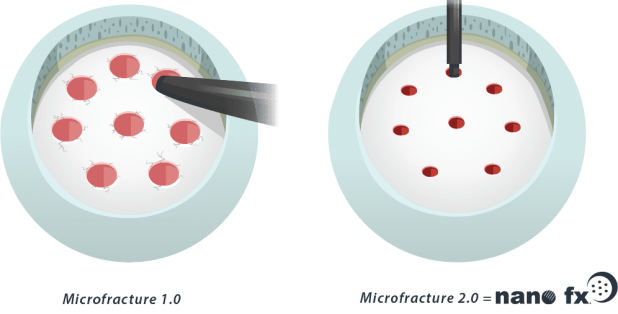Microfracture surgery is very common for athletes, especially at the college and professional levels, due to the physically demanding nature of their careers (Damaged cartilage in athletes is no surprise due to the amount of stress placed on the knee joint). Notable athletes such as Jason Kidd & Greg Oden have undergone the procedure, which is considered one of the least invasive cartilage procedure that allows for the return to sports and activities.
What is Microfracture Surgery?
Essentially, a series of small holes are made in the damaged joint surface, using a surgical awl, wire or needle. The idea is to reach the cells, marrow, and growth factors deep in the underlying bone marrow to fill in the defect area. This “biological paste” clots and creates a new “cartilage-like” tissue which covers the damaged area.
Microfracture surgery usually takes less than an hour to perform but the recovery requires a significant amount of time and effort from the patient. Post-operative rehabilitation exercises and physiotherapy can take months and the return to sport can take anywhere from 6 months to a year.
The opinions on whether athletes can return to a high level of sport are mixed. A recent study by Dr. Jimmy Andrews, a well-known sports surgeon, showed that approximately half of the NFL players (48%) treated with microfracture were able to return to play.¬π The concept itself is good, but the previous tools available to access the marrow were not designed to achieve the access necessary to reach the bone marrow.
However, as science & technology continue to advance, so does the innovative nature of medical procedures. Just 10 years ago, there were only limited  options for microfracture surgery. Today, new advancements have lead to an innovative instrument system, the NanoFx, which avoids many of the limitations associated with the traditional microfracture technique. The NanoFx® (Nanofracture) procedure is similar to microfracture in that it creates holes in the damaged area, but what makes it different is the size, depth, and number of holes being created. The NanoFx® system makes smaller and deeper channels, thereby stimulating more bone marrow into the damaged area. At the same time, it minimizes any disruption to the bone and for the same number of holes as microfracture, NanoFx® disrupts 6 times less surface area. More marrow access and less disruption makes Nanofracture a better procedure, which is why it has recently become the go-to procedure for certain professional athletes such as Jadeveon Clowney.
options for microfracture surgery. Today, new advancements have lead to an innovative instrument system, the NanoFx, which avoids many of the limitations associated with the traditional microfracture technique. The NanoFx® (Nanofracture) procedure is similar to microfracture in that it creates holes in the damaged area, but what makes it different is the size, depth, and number of holes being created. The NanoFx® system makes smaller and deeper channels, thereby stimulating more bone marrow into the damaged area. At the same time, it minimizes any disruption to the bone and for the same number of holes as microfracture, NanoFx® disrupts 6 times less surface area. More marrow access and less disruption makes Nanofracture a better procedure, which is why it has recently become the go-to procedure for certain professional athletes such as Jadeveon Clowney.
Now Athletes have a better* solution for cartilage defect repair!
-
1. Scillia AJ, Aune KT, Andrachuk JS, Cain EL, Dugas JR, Fleisig GS, Andrews JR. Return to play after chondroplasty of the knee in National Football League athletes. Am J Sports Med. 2015 Mar;43(3):663-8. doi: 10.1177/0363546514562752. Epub 2015 Jan 8. PubMed PMID: 25573391.




